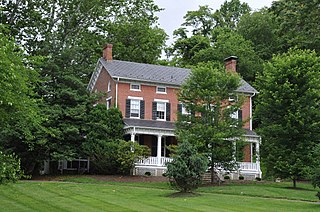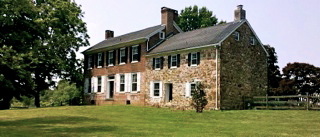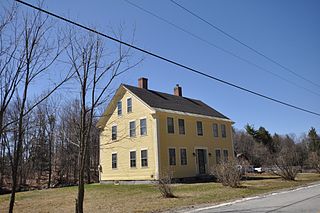
The Franklin Pierce Homestead is a historic house museum and state park located in Hillsborough, New Hampshire. It was the childhood home of the 14th president of the United States, Franklin Pierce.

Hidden Valley Farm is a historic home and farm complex located at Baldwin, Harford County, Maryland, United States. It consists of a mid-19th century vernacular Greek Revival brick farmhouse with several auxiliary structures. The house is a three-story, rectangular brick dwelling with a gable roof, with a two-story wing. The house features square-columned one-story porches across the façade and both sides of the wing. Also on the property are a mid-19th century barn, summer kitchen, and smokehouse, and later wood shed and garage.

The Masten-Quinn House is located on First Street in the village of Wurtsboro, New York, United States. It is a wooden Greek Revival house built in two phases in the 1820s, the center of a farm that remained working until the mid-20th century. Today it is one of the few remainders from the area's agricultural past as a canal town.

The McClelland Homestead is a historic farm in western Lawrence County, Pennsylvania, United States. Located along McClelland Road northeast of Bessemer, the farm complex includes buildings constructed in the middle of the 19th century. It has been designated a historic site because of its well-preserved architecture.

High Hill Farm, also known as Connemara Farm, is an historic farm complex which is located in Thornton, Delaware County, Pennsylvania.

The Stover–Winger Farm, also known as Tayamentasachta, is an historic, American farm complex that is located in Antrim Township in Franklin County, Pennsylvania.

Short Homestead, also known as the James Baxter House, is a historic home and farm located near Georgetown, Sussex County, Delaware. The earlier section is dated to the mid-18th century, and is a two-story, three-bay, double-pile brick structure. A two-story, two-bay frame wing was built in the mid-19th century. Both sections have gable roofs. The house was once the center of a 500-acre plantation. The house was "modernized" in the late-19th century.

Thomas Attix House is a historic home and farm complex located at Kenton, Kent County, Delaware. The house was built in about 1880, and is a two-story, three-bay, frame dwelling with a rear wing in a Gothic Revival / Queen Anne style. Contributing outbuildings include a brick milk house, sawn-plank bull pen, frame barn, cattle sheds, and machine shed. They date to the 19th and early-20th centuries.

W. D. Burrows House, also known as Hopewell, is a historic home and farm located at Kenton, Kent County, Delaware. The house was built about 1830, and is a two-story, five-bay, center hall plan brick dwelling. It has a full basement and gable roof. Also on the property are a contributing barn, a machine shed, chicken house and assorted storage sheds. They are dated to the late-19th and early-20th centuries.

T. H. Denny House, also known as "Mount Pinder," is a historic home and farm located at Kenton, Kent County, Delaware. The house dates to the last quarter of the 18th century, and is a two-story, five-bay, center hall plan brick dwelling. It has a gable roof and the front facade features an entrance portico added in the mid-19th century. It has a rear wing also added in the mid-19th century. Also on the property are a contributing barn, stable, and machine shed.

Jefferson Lewis House is a historic home located at Kenton, Kent County, Delaware. The house was built about 1800, and is a two-story, three-bay, center hall plan stuccoed brick dwelling with a gable roof. Attached is a rear frame wing. The front facade features a porch, added in the late-19th century. Also on the property are three two-story barns, and a mix of late-19th and early-20th-century milk houses, corn cribs, machine sheds and chicken houses.
Mount Pleasant, also known as the Samuel Cahoon House, is a historic home located near Smyrna, Kent County, Delaware. It built about 1810, and consists of a two-story, five-bay, gable-roofed brick main house with an interior brick chimney stack at either gable end and a one-story, gable-roofed brick kitchen wing. It is in a late Georgian / Federal vernacular style and measures 43 feet by 25 feet. Also on the property are a contributing early 19th-century smokehouse and barn.

James Stewart House, also known as Holly Farm, is a historic home and farm located near Glasgow, New Castle County, Delaware, United States. The oldest section dates to the second half of the 18th century, with additions dating to the 18th and 19th centuries. It consists of three distinct two-story, gable-roofed, brick sections joined at the endwalls, plus a one-story, brick lean-to. The oldest section is the first floor of the central section. Also on the property are contributing outbuildings including a brick smokehouse, shop, a corn crib/granary, two sheds, a privy, a bank barn, a milkhouse, and a machine shed.

J. McIntyre Farm is a historic farm located near Newark, New Castle County, Delaware. The property includes five contributing buildings. They are a stuccoed brick house with frame Gothic Revival style additions, a stone bank barn, and three late 19th century outbuildings: a braced frame corn crib, a braced frame machine shed, and a two-story granary covered with corrugated metal siding. The house is a two-story, three-bay, brick building with an added central cross-gable, and a frame wing extending from its west endwall. The barn walls are constructed of large, dark fieldstones with large, rectangular quoins, and in places is covered with a pebbled stucco.

Poplar Hall is a historic home and farm located near Newark, New Castle County, Delaware. The property includes six contributing buildings. They are an 18th-century brick dwelling with its stone wing and five associated outbuildings. The house is a 2+1⁄2-story, gable-roofed, brick structure with a 2+1⁄2-story, cobblestone, gable-roofed wing. It was substantially remodeled in the mid-19th century in the Greek Revival style. Also on the property are a contributing 2+1⁄2-story crib barn, frame smokehouse, frame dairy, implement shed, and cow barn.

The Charles C. Weldon House is a historic home located at Odessa, New Castle County, Delaware. It is a 2+1⁄2-story, three-bay brick dwelling with a 2+1⁄2-story, two-bay frame addition. It has a 2+1⁄2-story, parged concrete rear wing. The main block has a stepped brick cornice and two gable, end chimneys. Also on the property is a mid-19th-century granary and an early-20th-century gambrel-roofed barn.

Ashton Historic District is a national historic district located near Port Penn, New Castle County, Delaware, United States. It encompasses six contributing buildings associated with an original settler and his immediate descendants on early land grant in St. Georges Hundred. The three structures associated with the early occupation are the Robert Ashton House, the Joseph Ashton House, and the John Ashton House. The Robert Ashton House, probably the earliest of the group, is a frame, five-bay, single-pile, gambrel-roofed building with shed-roofed dormers. The Joseph Ashton House, consists of an early-18th-century two-story, three-bay, hall-and-parlor-plan brick structure with a late-18th or early-19th century brick wing. The John Ashton House, consists of a brick, early-18th century two-story, three-bay, hall-and-parlor-plan house with a frame wing.

The John Richardson Homestead is a historic house on Hancock Road in Dublin, New Hampshire, United States. Built about 1798, it is a well-preserved example of a modest Federal period farmhouse. The house was listed on the National Register of Historic Places in 1983.

The David Hanaford Farmstead is a historic farm in Monticello Township, Minnesota, United States. It was first settled in 1855 and features a farmhouse built in 1870 and a barn from around the same time. The farmstead was listed on the National Register of Historic Places in 1979 for having local significance in the themes of agriculture and exploration/settlement. It was nominated for being "an excellent example of an early Wright County farmstead developed by a pioneer family from New England."
The Aage and Kirstine Larsen Homestead was listed on the National Register of Historic Places in 1993. It was deemed significant as a well-preserved example of an early twentieth-century Sheridan County homestead which achieved a measure of success and permanence. The Larsens were among the thousands of settlers who arrived in Sheridan County during the first two decades of the twentieth century, and the homestead they established was initially typical of hundreds of such farms operated during the county's early years of settlement. Most of these early homesteads were either abandoned or merged into larger farm operations, in either case leaving relatively few physical remains. The relative economic success achieved by the Larsens, however, allowed them to expand their farm holdings and increase the number and size of the farm's buildings, resulting in the building complex which survives today.




















